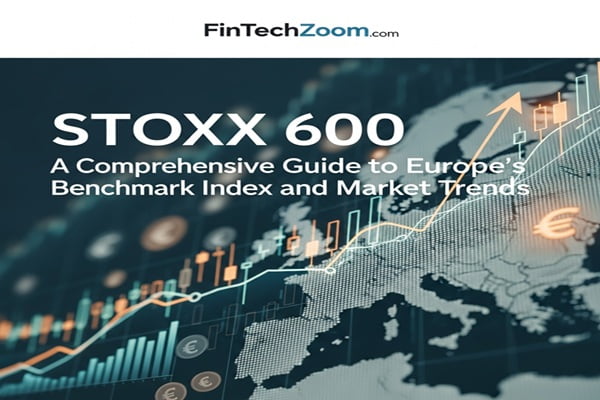
If you’ve been trying to make sense of European markets or want a clearer picture of how major companies across the continent are performing, the FintechZoom SToxx 600 is one of those benchmarks you’ll keep coming back to. It’s packed with signals about economic trends, sector strength, and shifting investor sentiment. Think of it as a snapshot of how Europe’s corporate landscape is evolving — and FintechZoom makes it even easier to understand with sharp analysis and real-time updates.
This guide breaks everything down in a friendly, straightforward way so you can actually use this index to strengthen your investing decisions. Whether you’re studying sector behavior, tracking macro trends, or exploring new strategies, there’s a lot you can learn from watching the SToxx 600 closely.
What Makes the SToxx 600 So Important?
The SToxx Europe 600 includes 600 companies of different sizes across 17 countries, ranging from the UK and Germany to Switzerland, France, Italy, and the Nordic economies. Because it blends large-cap, mid-cap, and small-cap companies together, it offers a surprisingly complete view of Europe’s equity landscape.
One of the best things about this index is how varied it is. Instead of focusing on just one country or one type of company, it pulls from multiple industries and markets. That means when the index shifts, it often reflects a real, broad-based shift rather than a reaction to a single sector.
FintechZoom brings this index to life by layering real-time charts, sector breakdowns, predictive data, and market commentary on top of the raw numbers. It’s an easy way to turn complex market activity into something you can act on.
A Friendly Breakdown of Major Sectors in the SToxx 600
Instead of listing everything in table form, here’s a smooth, narrative version that’s easier to digest.
Financials hold the biggest share of the index. Banks and financial institutions from the UK, France, and Switzerland dominate here, including giants you’ll recognize quickly such as HSBC, UBS, and BNP Paribas. With interest rates shifting and policy updates from the European Central Bank, this sector has a significant influence on how the index moves.
Next comes industrials, a category driven largely by powerhouse nations like Germany, France, and Sweden. Companies such as Siemens, Airbus, and ABB shape this segment, which reflects manufacturing strength, infrastructure investment, and transportation growth.
The consumer discretionary group also makes up a major portion of the index. This segment includes upscale brands and entertainment companies from Italy, France, and the UK — think Ferrari, LVMH, and Burberry. When consumer confidence rises or falls, this segment responds quickly.
Healthcare is another big contributor, with market-shaping companies such as Roche, Bayer, and Novo Nordisk. Countries known for their medical innovation — Germany, Switzerland, and Denmark — lead this segment.
On the tech side, technology companies from Germany, Sweden, and the Netherlands add significant weight to the index. Brands like ASML, SAP, and Ericsson continue shaping Europe’s digital future, especially with semiconductor demand and AI adoption accelerating.
Energy remains a core part of the SToxx 600 as well. Norway, the UK, and France contribute major players such as BP, Equinor, and TotalEnergies.
You’ll also find important contributions from the consumer staples sector (brands like Nestlé, Danone, and Unilever), materials (including BASF and ArcelorMittal), utilities (such as Enel and Iberdrola), and real estate groups represented by companies like Vonovia.
Put together, these sectors create a multi-layered view of how Europe’s companies perform collectively — and how global events pressure different industries.
Why FintechZoom’s Coverage Deserves Attention
Plenty of financial platforms show you basic index changes. FintechZoom does far more by highlighting deeper market behavior. Instead of just showing gains or losses, the platform examines what’s driving those movements.
You get:
-
Smart sector-level insights
-
Correlation patterns
-
Forward-looking commentaries
-
Market sentiment tracking
-
Scenario-based models
-
Interactive charts and tools
For example, when the European Central Bank indicates a rate change, FintechZoom doesn’t just recap the news. It examines which industries might benefit or struggle, and how the ripple effects could play out over the following months.
This type of context is priceless for investors who want to build their strategies before the rest of the market reacts.
How the SToxx 600 Has Performed Over Recent Years
Instead of using a table, here’s a clearer storytelling approach to highlight sector fluctuations between 2020 and 2024.
During 2020, the energy sector struggled with a dramatic drop, posting a significant decline. At the same time, technology companies surged as digital adoption grew rapidly. Healthcare also performed well due to increased global demand for medical innovations. Meanwhile, financials, industrials, and consumer discretionary companies were hit hard by lockdowns and uncertainty.
By 2021, energy began stabilizing with modest gains, while tech and healthcare continued building on their strength. Consumer-focused sectors also saw recovery as spending slowly resumed.
In 2022, technology and healthcare maintained steady performance, while financials and industrials experienced slight declines. Energy remained positive, although not dramatically.
Then came 2023 — a standout year for energy. The sector jumped sharply due to supply constraints and geopolitical tensions. Industrials also bounced back strongly, while financials, tech, and discretionary sectors delivered healthy mid-range growth.
In 2024, energy continued its upward run with another impressive year. Industrials, consumer discretionary, and financials recorded solid returns, while tech and healthcare posted more moderate but still supportive growth.
This five-year window shows that sector leadership rotates frequently. Watching these shifts can help investors identify where momentum is building next.
What’s Shaping the SToxx 600 in 2025?
Several forces are influencing the index right now:
1. Monetary Policy
ECB decisions play a direct role in market behavior. Even small changes in interest rates can move banks, real estate companies, and consumer-facing industries.
2. Energy Transformation
Europe’s push toward renewable energy is reshaping utilities, materials, and traditional energy sectors. Companies that adapt quickly tend to outperform.
3. Trade Relationships
Partnership changes between the EU, the US, and China affect manufacturing, automotive, and technology exports — especially in Germany.
4. Geopolitical Uncertainty
Conflicts near the continent influence commodity prices and overall investor confidence.
5. Tech Innovation
Advances in AI, semiconductor advancements, and clean tech continue shifting leadership within the index. Technology-influenced sectors are becoming more central.
How Investors Can Approach the SToxx 600
You can access the SToxx 600 through individual stocks, ETFs, index funds, or derivatives such as options and futures. The approach you choose depends on your experience level and appetite for risk.
Here are some helpful strategies:
-
Diversified approach: Mix exposure across several sectors to reduce volatility.
-
Momentum-based strategy: Focus on industries showing clear strength.
-
Dividend-focused strategy: Utilities and consumer staples often provide strong, stable payouts.
-
Growth-based strategy: Technology and healthcare companies lead innovation and may offer higher long-term returns.
One thoughtful way to view this index: it’s not simply an investing tool — it’s also a window into Europe’s economic heartbeat.
How ESG Values Are Reshaping the Index
Sustainability guidelines are changing how companies are weighted within the SToxx 600. ESG-focused funds continue growing, and many now screen companies based on environmental responsibility, ethical production, and governance strength.
What’s changing?
-
Companies with strong ESG compliance are gaining more attention.
-
Renewable energy firms are rising in importance.
-
Investors are rewarding long-term sustainability commitments.
This shift reflects Europe’s regulatory climate and the growing role of responsible investing.
Also Read : Axcessa Explained: Meaning, Functions, and Its Growing Role in Modern Business and Technology
What the Future May Look Like
Short-term swings are unavoidable, but the bigger story revolves around Europe’s innovation, policy direction, and trade position. As companies integrate AI, expand renewable energy adoption, and adjust to global supply chain patterns, the index could see renewed strength in sectors such as clean energy, advanced manufacturing, and high-tech industries.
FintechZoom helps investors see these changes early by offering context, trends, and forward-looking analysis — turning market noise into useful insights.
FAQs
1. What is the SToxx 600 index?
It’s a blend of 600 companies across 17 European countries, representing various market sizes and sectors.
2. How does FintechZoom cover it?
Through live updates, sector research, historical insights, predictive tools, and market commentary.
3. Which sectors hold the biggest positions?
Financials, industrials, and consumer discretionary lead, with healthcare and technology close behind.
4. Is it good for long-term investing?
Yes. Its broad diversification makes it a strong benchmark for long-term exposure to European equities.
5. How can someone invest in it?
ETFs, index funds, futures, options, or direct stock selections depending on strategy and risk tolerance.


